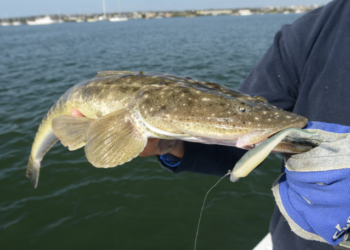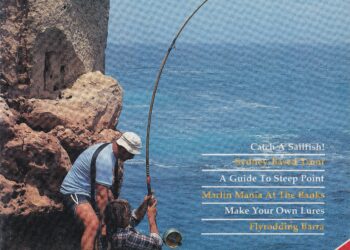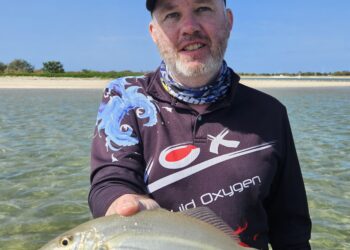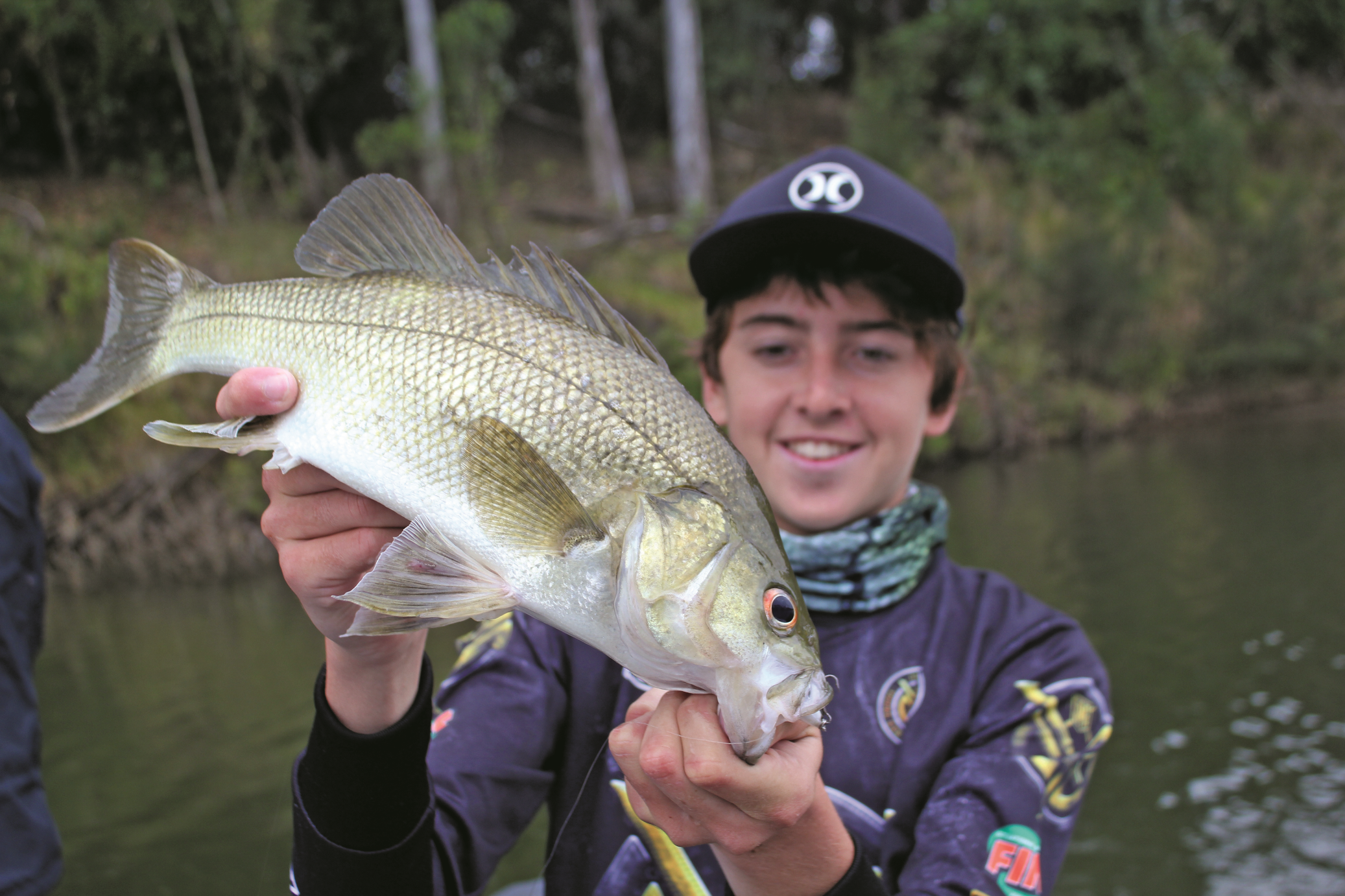
FOR the uninitiated, the pursuit of Australian bass can be something of a realm of the unknown. Luckily, DAVE RAE is here to help you out!
IF you’re thinking about taking up bass fishing, this article is for you. Catching bass isn’t that difficult. With the right gear, it’s actually relatively easy. So don’t think bass fishing is only for elite or highly experienced anglers. At the most basic level, all the budding bass angler really requires is a light rod and reel, some suitable line and a smallish lure. Any lure that’s designed to be used in a river or a dam will catch a bass sooner or later, if you try long enough.
Why is it then that most keen bass anglers have several tackle boxes that all overflow with lures and numerous rods and reels? In truth, there’s a huge difference between catching the odd bass and catching bass on a regular basis. Also, there’s the trophy fish to consider. Bass don’t become big by being easy to catch. The big ones are harder to find, much harder too fool and exponentially more challenging to get clear of snags and into your landing net or hand.
By now you may be getting an inkling that there’s more to catching bass than simply chucking any old lure around, and that should the bass bug bite, then you too will end up with bulging lure boxes and favourite outfits … so don’t say you weren’t warned!
Rod & Reel
While baitcast and spin outfits are most commonly used by bass anglers, a growing number of fishos are targeting these popular native sportfish with fly gear. Fly fishing for bass is worth an article in its own right so we’ll stick with detailing lure fishing tackle here.
Spin outfits have become much more popular in recent years due to a spike in reel quality and their ability to handle lighter lures than can be cast with a baitcaster. For light lures in the sub-50mm lengths, and for un-weighted or lightly weighted soft plastics, a spin reel is definitely the way to go.
Baitcast reels are harder to use because they require delicate thumb pressure to prevent the spool of the reel spinning faster than the lure as it moves through the air. That said, too much pressure shortens the cast. Baitcasting is a skill that brings great pleasure. The challenge of making a cast into a tight snag and then hooking up is extremely satisfying. Baitcasters can handle heavier line than a spin reel, which comes in handy if you’re fishing amongst submerged boulders and/or nasty timber where large bass are a possibility.
A general estuary spin rod in the 1.8m-2.1m range is all that’s required. Stick to the shorter end of the scale if you plan to walk the banks or fish from a canoe as longer rods are more difficult to use in confined spaces.
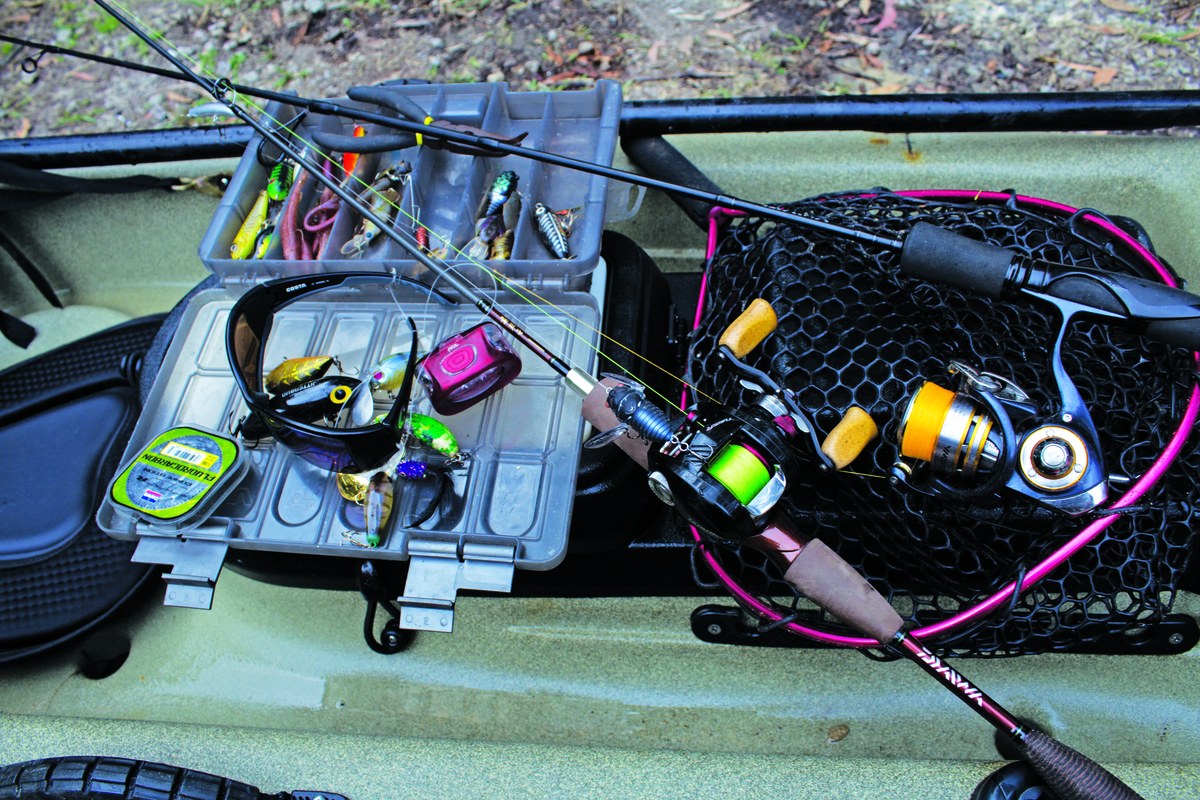
Lures
Bass are enticed by a wide variety of lure styles of the small to medium ilk. It’s vital to have a variety of styles in order to best deal with the many and varied situations that you’ll likely encounter. The most well known “bass lures” include hard-bodied divers in the 40–65mm lengths, particularly those with rounded bodies.
The idea is to cast the lure tightly against any sort of likely bass-holding structure, say, timber snags, rocks, shaded holes and weedbeds, and then wind it back. While straight winds (aka slow rolling) work quite well, there’s nothing quite as good as a slow but erratic retrieve, one that’s punctuated with flicks of the rod tip and generous pauses. Medium depth divers, say a 1m dive depth, work well in timbered rivers while deep divers are great in the deeper waters of rocky gorges and dams.
Suspending hard-bodies are ideal in water that lacks submerged timber because, when paused, they hang at depth, right in the face of a trailing bass, and when the pause is concluded with a minute rattle or two, it’s often more than a reluctant fish can cope with. Rivers with banks lined with tussock grass or water lilies are suspender friendly.
Buoyant divers are suited to timbered “tiger country” because when paused they reverse backwards (maybe only 50mm), and float up and over submerged timber; the idea is to tickle these lures back and stop winding as soon as timber is encountered. This works so well that much of the time the excitement comes when you hook-up behind a branch … exciting but costly on lures if you insist on using light leaders.
Surface lures offer the most exciting fishing of all. Larger black lures are favourites in low light conditions while smaller natural imitations are good for daytime work. Surface lures have most often been touted as a “nocturnal only” option, and while they are brilliant at drawing massive strikes in the dark, they also offer exciting fishing opportunities during hot and humid summer days. Cicadas and grasshoppers become very active in the warmer months and a plastic imitation of either can prove irresistible, particularly during insect-laden scorchers and the still afternoon just prior to a big storm.
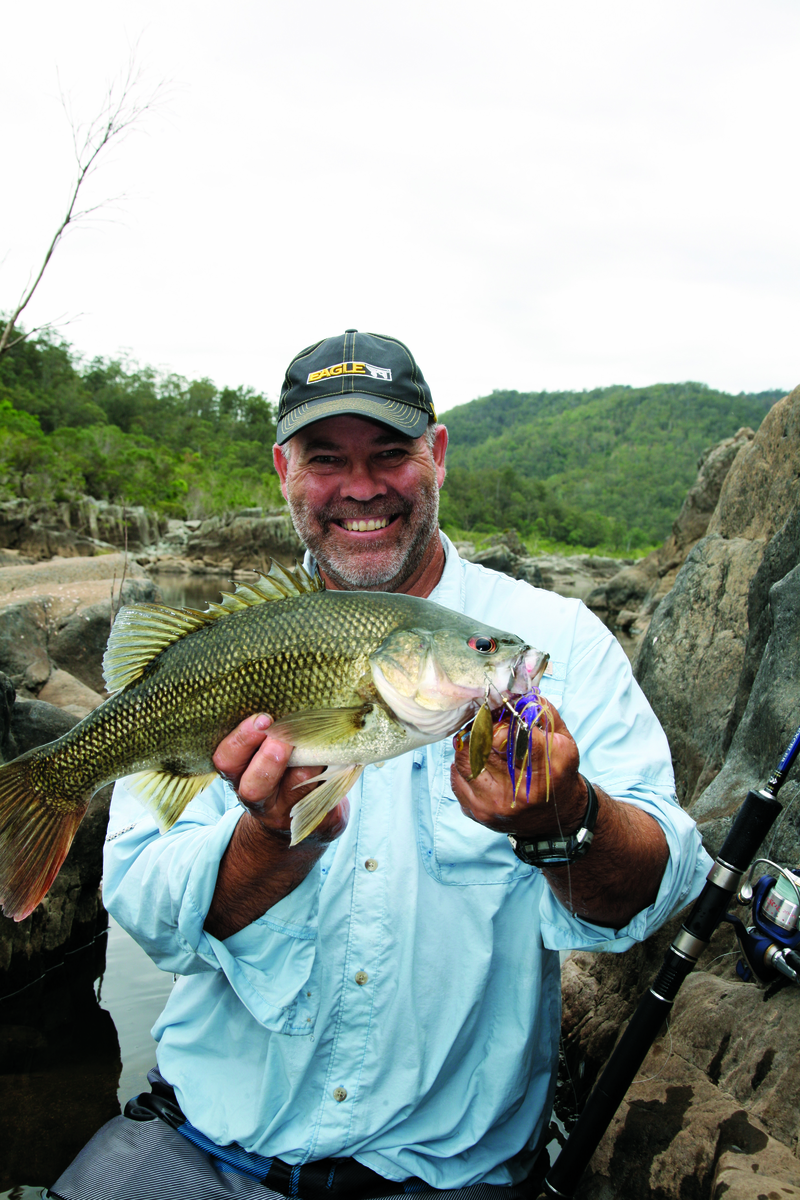
The trick with surface lures is to land them in the zone and then do nothing for as long as you can stand it, say, 20-30 seconds; then give the lure the slightest tap. Often the hit that follows is so much more explosive than you’ll ever see when a natural food item is engulfed off the top … I don’t understand it, but that’s the case!
Spinnerbaits are more often associated with Murray cod, but they are a productive bass option in smaller weights and sizes. Spinnerbaits can be fished at any depth because it’s the angler who determines at which depth the lure runs. Retrieving as soon as the lure hits the water, with a rod tip held high and a faster retrieve speed, the lure will keep near the surface. Generous pauses after casting and during the retrieve will keep the spinnerbait down near the bottom; and there’s endless variety in between. They tend to be snag-resistant because they orientate themselves with the hook point lying upwards.
Soft plastics are similar to spinnerbaits in regard to depth capacity but they are quite prone to snagging on submerged timber and are best rigged weedless on a worm hook when fished amongst the timber. Soft plastics can be the most productive option during times when the bass are slow to bite or when fishing open water amongst schooling fish. Tournament anglers will almost always try soft plastics when fishing in dams.
There are a multitude of other lure styles that work for bass, including jigs, vibes, lipless minnows and chatterbaits. If you get hooked on bass fishing – and you most probably will – then you’ll learn more about these more specialised options as you develop your skill and experience.
Handling bass

While placing your hand directly beneath a bass and comfort lifting it into the canoe or boat is straightforward, they tend to flip while the hook is being removed, making careful handling a must. As bare legs and sharp hooks don’t make for a relaxing trip, I prefer to employ a small handled landing net with large plastic mesh. The mesh is friendly to both fish and lures. Hooks that become embedded into the mesh of a knotted twine net are very difficult and frustrating to remove plus the twine has the potential to damage the fish’s fins and protective slime coating.
Use pliers to gently remove the hooks from the bass’s mouth and then hold the fish by getting a good grip on the lower lip with one hand and support its belly with the other. Most quality lures come with chemically sharpened hooks, which are by nature small, sharp and relatively light. Carefully check the hooks on your lure after unhooking a bass to ensure none are bent or damaged.
A point to note when handling bass is that they have a set of very sharp spikes on their gill plate. These produce a painful wound, similar to being spiked by a flathead, so steer clear! The fish’s dorsal spines are deadly sharp as well.
Bass anglers generally use fork length rather than weight to indicate the size of the fish they’re catching. A bass with a fork length of 50cm or more is considered a trophy in any water while a 40cm fish that’s been landed in a river is a nice one. A bass that tops 55cm is a monster! Measure your bass on a wet brag mat and ensure the fish is quickly returned to the water to maximise survivability.
Handy kit
The following are suggestions for additional gear that could come in handy during your bassing expeditions this summer.
- Boots: Some sort of footwear is essential for those of us who chase bass from the shore or from a canoe in freshwater rivers. River stones and broken twigs and branches play havoc on bare feet so covered footwear is the solution. Joggers are OK but they tend to let small pieces of gravel collect in unwanted nooks and crannies. Neoprene booties with a solid sole are the bee’s knees as they keep small stones out while protecting your feet from pebbles and stones.
- Headlamp: Given that the best bass fishing occurs at night, you should include a quality headlamp in your tackle box. My advice is to get a compact LED lamp. A headlamp with a red light option is preferred as you’ll be able to rig, change lures and spot overhanging branches with minimal disturbance to nearby fish. A white light is great for travelling and spotting snakes as you walk between the river and the vehicle. The strength of the lamp is measured in Lumens – a good benchmark is a 40 Lumen light with the option of 70 Lumens if needed.
- Insect Repellent: One downside as far as lamps go is that on a warm summer’s night, every bug from within 50m is likely to end up buzzing in front of your face. The answer is to apply insect repellant and to stick to the red light.
- Polarised Sunnies: Every fisherman should have a pair of decent polarized sunnies – and bass anglers need good sunnies more than most. They’re essential kit as they enable you to spot snags and free-swimming fish that would otherwise be hidden behind a curtain of glare. Do some research before purchasing as most manufacturers have freshwater specific lenses; usually they are the browns as opposed to the blues that are recommended for saltwater fishing.
- Lines: Braided lines are the best option for bass fishing because their minimal stretch helps telegraph the minutest bumps and bites back onto the rod tip. Because these lines are very fine, they can cast small lures much better than the equivalent strength mono. Given that most braids are highly visible and susceptible to contact with rock and timber, the usual plan is to tie 1-2m of nylon trace between the lure and the braid using a Double Uni Knot or similar connection. Abrasion-resistant fluorocarbon offers a tougher, less visible option.
- Swim Goggles: These compact goggles make it easier to retrieve snagged lures and to go for a look-see whenever the fancy takes you. While not a preferred option on cool mornings, a dip becomes more appealing on a warm day in clear freshwater. You’ll learn a great deal about bass by going for a swim with goggles on.
- Maps/Google Earth: It’s a real pleasure to find new spots. Understandably, bass fishos tend to keep their gun spots closely guarded – the whole idea of this game is to fish virgin water as much as possible. Google Maps and regional topographic maps are the most efficient means of fishing new water. These tools are invaluable for finding new spots to explore. Stick to the brackish and freshwater reaches of a river or lagoon, find an access point and go in search of fish. The more you explore, the more success you’ll have. Look for bridges, crossings, rock bars, side creeks and even the smallest lagoons and waterholes. Bass are programmed to head as far up a system as they can after their winter spawning in the estuary. You’ll be surprised at how many fish will be in even the skinniest water – and sometimes surprisingly big ones as well. Bass fishos are in essence no different to the fish they target. When a keen bass angler wants to get wet, he or she will go to extraordinary efforts to get access to good-looking water. They’ll go to similarly exhausting trouble to bring their canoe or kayak with them, often ignoring how difficult it will be to get it back to the vehicle. It’s all part of the unique pleasure that chasing these tough little natives offers.
So go and find yourself some likely bass water and have a crack – the next five or six months over spring, summer and early autumn are the key times for bassin’ fun!












